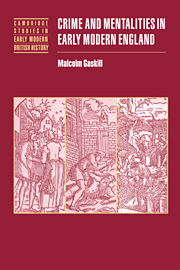2 - The social meaning of witchcraft, 1560-1680
from Part I - Witchcraft
Published online by Cambridge University Press: 05 July 2012
Summary
If I should goe to pen all of these sorts [of witches], then I should have no end, or at least too big a volume.
Stearne, A confirmation and discovery of witchcraft, p. 32Early modern witchcraft has no single easily expressible definition; instead, many contingent meanings emerged from interactions between people, social environment, customs and beliefs, ideas and communications, and the administration of justice. In pursuit of these meanings - and the mentalities they reflect - this chapter takes as its starting point two traditional stereotypes of witchcraft: the dominant historical model of accusations, and the witch-figure as described in contemporary literature. Although both versions can be verified by evidence drawn from the reality of daily life, overall neither satisfactorily accommodates or accounts for the variety of circumstances apparent in individual cases. The intention here is not to establish new stereotypes, still less to explain the rise in witchcraft prosecutions. Rather, the following discussion aims to expand our understanding of what witchcraft really meant, and explores the range of cultural contexts in which accusations took place with a view to considering those accusations in general terms of interpersonal cooperation and conflict within villages, and contrasting forms of social power. Seen thus, witch-beliefs and witchcraft accusations illustrate the struggle for survival and authority taking place right across early modern English society, and in the process offer intriguing insights into the complex ways in which ordinary people behaved, thought and communicated within a variety of practical quotidian contexts.
- Type
- Chapter
- Information
- Crime and Mentalities in Early Modern England , pp. 33 - 78Publisher: Cambridge University PressPrint publication year: 2000



